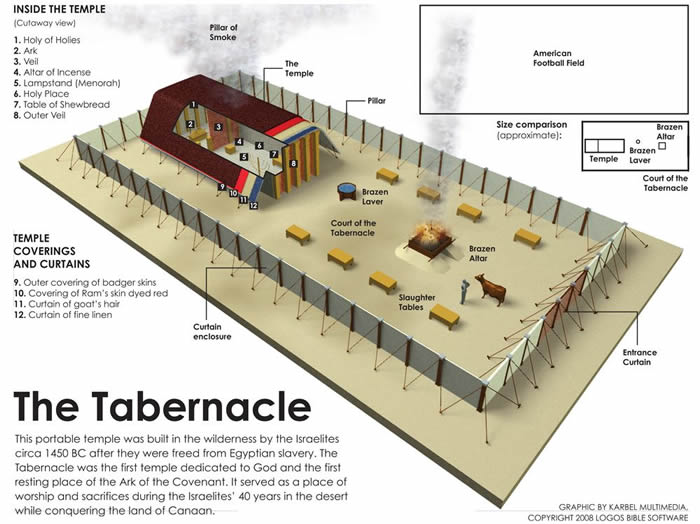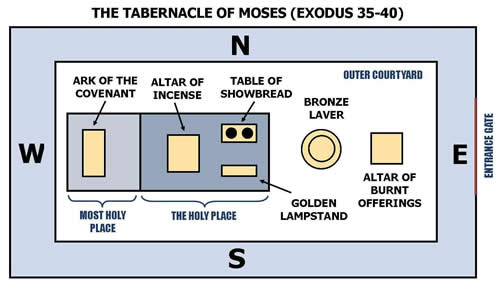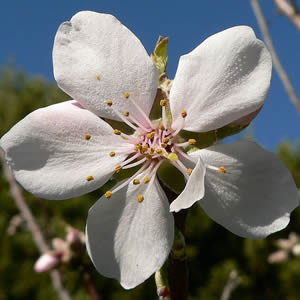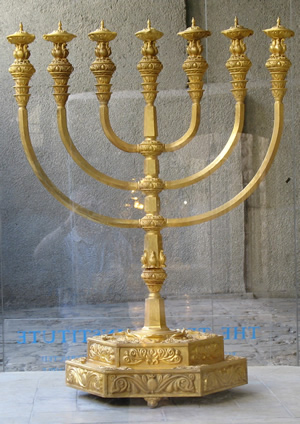On Friday, February 8, 2019, Yujin wrote,
Here is a graphical rendition of the tabernacle that Bezalel, Oholiab and the other workers crafted for Israel to worship the LORD. Notice how the size compares to an average size American football field. Notice the movement of worship from East to West, from what is most common (outer courtyard) to what is most holy (Holy of Holies). Remember, only priests (lineage of Aaron) could enter the Holy Place and only the High Priest could enter the Holy of Holies and only once a year on the Day of Atonement. I have included a little fuller discussion of the tabernacle, particularly the Holy Place and the Holy of Holies, the two inner rooms of the Tabernacle, by one of my former teachers, Elmer Towns, below. It's not long, but it's good. I encourage you to read it.

Here is a simpler structural look that shows the placement of the main furniture in the tabernacle:

From Bible Answers for Almost All Your Questions by Elmer L. Towns:
The tabernacle built by Moses and, later, Solomon’s temple were divided into the Holy Place and the Most Holy Place (or Holy of Holies). To understand these places, it will help if we first understand the concept of “holy.” At its most basic meaning, holy simply means “set apart” or even “different.” God is holy because He is absolutely different, completely set apart from everything else. He is completely different from all other things that are called “gods.” He is also completely set apart from sin, which is probably the concept that most people associate with God’s holiness. This example may help explain the concept further: the word bible is simply from the Latin for “book.” Although the word Bible has become a technical (or semi-technical) term for the Word of God, the term itself just means “book.” There are many books in the world. That is why on the cover or the title page we often see the official title as “Holy Bible.” In other words, there are many bibles (books), but this Book (Bible) is holy; that is, it is different, set apart from all other books, because it is the Word of God.
The Holy Place and the Most Holy Place were first and foremost places that were set apart. They were completely different from any other place on Earth, because the presence of God was uniquely present there. The Israelites were forbidden from making any images to represent God (Exodus 20:4–5). However, human beings are physical and visual, so God did give the Israelites an object that would help them sense His presence among them—the tabernacle (a tent that served as a portable temple), which was later replaced by a grand temple in Jerusalem. The Holy Place and Most Holy Place function the same in both settings.
The whole tabernacle was holy in that it was set apart for worship and sacrifices to God. However, the tabernacle was separated into 3 areas, the Outer Court, the Holy Place, and the Most Holy Place (or Holy of Holies). Priests and Levites ministered in the Outer Court as they offered sacrifices for sin and guilt as well as the other sacrifices. In the center of the Outer Court was a tent that only the priests could enter. This place was set apart—it was holy.
The tabernacle had only one entrance. Upon entering, a priest would be in the Holy Place, where there were three articles of furniture. One was the golden lampstand, which was to be kept burning continually, giving light to the Holy Place. The second article of furniture in the Holy Place was the table for the bread of presence (or the table of showbread). This bread was baked fresh every day, and only the priests were allowed to eat of it as it was holy as well. Jesus claimed to be the fulfillment of both of these symbols as the Light of the World (John 8:12) and the Bread of Life (John 6:35). The final article in the Holy Place was the altar of incense. Special incense was to be burned each morning and evening as an offering to the Lord. The Holy Place was set apart (holy) because it was a special representation and reminder of the presence of God.
At the back of the Holy Place was a smaller chamber called the Holy of Holies or Most Holy Place. In this smaller room was the ark of the covenant. On top of the ark was a special area called the mercy seat. This was seen as the throne of God. While God is omnipresent, this location was seen as a special place for God to dwell in the middle of His people. This second chamber could only be entered by the high priest on one day of the year, the Day of Atonement, and only with a blood sacrifice. The high priest would enter the Most Holy Place with smoke (from the altar of incense) to help shield his view and sprinkle blood on the ark of the covenant to atone for the sins of the people. Anyone who entered this chamber when he was not supposed to would be killed.
The tabernacle and the temple emphasized the presence of God in the midst of His people. God was always there and accessible. At the same time, the Holy Place and Most Holy Place emphasized God’s holiness and His inaccessibility due to the sins of the people.
When Jesus died on the cross, three Gospels report that the curtain of the temple, that barrier between the Holy Place and Most Holy Place, was supernaturally torn in two (see Matthew 27:51; Mark 15:38; and Luke 23:45). The torn curtain symbolized that the way to God was now open to all through the death of Christ. The blood of an animal was no longer needed. Hebrews 10:19–22a explains, “Therefore, brothers and sisters, since we have confidence to enter the Most Holy Place by the blood of Jesus, by a new and living way opened for us through the curtain, that is, his body, and since we have a great priest over the house of God, let us draw near to God with a sincere heart and with the full assurance that faith brings.”
On Saturday, February 8, 2014, Yujin wrote,
The people are bringing much more than enough for the construction work which the Lord commanded us to perform (Exodus 36:5).
I know that this text is often the basis for sermons on generous giving, for that appears to be what we see here in Israel's response to God's command to give, as each person is willing, the raw materials to build the tabernacle.
What is puzzling for me is this. How is it that such a generous people would also be labeled as always stiff-necked and rebellious? This very generous group would later grumble against the Lord about taking the land of Canaan, and God would punish them for this with forty years of wandering and death along the way to everyone twenty-years and older. In Psalms and then Hebrews God would declare of these people, "They will never enter my rest" (cf. Psalm 95:11; Hebrews 3-4).
Friends, I think this reveals the unsteadiness and unreliabilty of our faith. The faith that springs from free will may blossom for a moment but then it will shrivel up at the first instance of adversity. A great moment of generous giving can in the next moment be overshadowed by universal rebellion and unbelief.
So, friends, while we encourage each other to give generously to the works of God, let us not be too smug about our spiritual health because we gave. The important thing to remember is not the giving but obeying the command of God. Again, it is not in the giving, nor even in sacrifice, but obedience.
What good is it if we give to this or that cause without a command from God but neglect to obey the things that God has clearly commanded? Do you think that God will give you a break because you were charitable? He didn't give the people of Israel a break at Kadesh-Barnea. King Saul did not understand that God desired obedience over sacrifice. He lost God's favor and the kingdom.
The Roman Catholic Church tried to convince people that they could buy God's pardon by giving money to the church. This was one of the most corrupt and sacriligious practices of the church, prompting the great Reformation.
Today, sometimes people are pressed to give to this project or that ministry with the promise of God's blessing in return. Yet these things are neither commanded by God nor is there a biblical basis for blessing. These are just things churches and their leaders want to do. Admittedly, for God, but not by His direct command. There may be nothing wrong with them, but let us be careful when we say things like "God commands us to..." or "If you want to be apart of what God is doing, then..."
We must make a clear distinction between what God has commanded and what we desire for ourselves. The important thing is obeying God in His Word.
On Friday, February 8, 2013, Yujin wrote,
Sometimes visuals help in reading through the details in passages like this. The Jewish lampstand is called a menorah. Here is the text followed by a picture of a possible replica of the ancient menorah by the Temple Institute (www.templeinstitute.org), as well as a picture of an almond blossom, which was to be the mold for much of its design. You can judge whether they did a good job on the replica or not.
Then he made the lampstand of pure gold. He made the lampstand of hammered work, its base and its shaft; its cups, its bulbs and its flowers were of one piece with it. There were six branches going out of its sides; three branches of the lampstand from the one side of it and three branches of the lampstand from the other side of it; three cups shaped like almond blossoms, a bulb and a flower in one branch, and three cups shaped like almond blossoms, a bulb and a flower in the other branch—so for the six branches going out of the lampstand. In the lampstand there were four cups shaped like almond blossoms, its bulbs and its flowers; and a bulb was under the first pair of branches coming out of it, and a bulb under the second pair of branches coming out of it, and a bulb under the third pair of branches coming out of it, for the six branches coming out of the lampstand. Their bulbs and their branches were of one piece with it; the whole of it was a single hammered work of pure gold. He made its seven lamps with its snuffers and its trays of pure gold. He made it and all its utensils from a talent of pure gold (Exodus 37:17-24).
| Almond Blossom | Menorah (Reconstruction from Temple Institute) |
 |
 |
I tried to find a good replica of the Ark of the Covenant online, but I surprisingly could not find one (through Google search) that accurately followed the description given for the ark. Some forgot to make the poles overlaid with gold. Others forgot the rings or put them at the top or the midde rather than at the foot of the ark. Others simply had only the wings of the cherubim, even though the text clearly says that their faces were toward each other and the mercy seat. Some forgot the mercy seat altogether and others made it as a circle, even though the text clearly describes rectangular dimensions. It is amazing that people would spend hundreds and thousands of dollars, not to mention all kinds of time, to build a replica that would not exactly follow the biblical description. What is more, to the faithful, how could people be so careless when the Scriptures clearly show how God treated all these matters with exacting precision, sometimes on pain of rejection or death.
This causes me to reflect on the condition of our personal testimonies. What attention do we give to the priorities of God in our lives, for our families, in our work? Are we carefree about it? Are God's interests overshadowed by our own? Rather than spiritual and moral precision in keeping with God's Word, would our efforts at holiness and obedience be described as approximate, in the ballpark, or perhaps even on the sidelines?
---------------
Just a simple observation. We read in Exodus 38:26 that there were "603,550 men." These were just the men twenty years and over. Quite a lot! If there was a woman for each of these men, we already have over 1.2 million people. Now, a modest estimate of 2 kids per couple would bring that number to 2.4 million. So, from the time Jacob entered Egypt to the time Moses brought them out, the number of people went from 70 to 2.5 million. This was how God, in part, fulfilled His promise to Abraham to make his offspring as many as the stars in the sky and the sand on the seashore (cf. Genesis 15:5; 22:17).
God is faithful!
On Friday, February 10, 2012 (Last Updated on 2/8/2013), Misty wrote,
22 Bezalel the son of Uri, the son of Hur, of the tribe of Judah, made all that the Lord had commanded Moses. 23 And with him was Aholiab the son of Ahisamach, of the tribe of Dan, an engraver and designer, a weaver of blue, purple, and scarlet thread, and of fine linen.
So Aholiab and Bezalel are the artisans who God chose and gifted for building the tabernacle. And together, they worked to make the Lord a beautiful dwelling place. The Lord planted wisdom and understanding in each, to do their respective jobs.
I notice that the people had to have their hearts "stirred to come and do the work". The tabernacle then is the gift of the Hebrew people to God. In fact, they brought so much that the people building had to tell them to stop. Can you imagine how this pleased God? He gave them the desire to build a place for him, and then he watched them enthusiastically give too much! He wanted them to get carried away! He wanted their tabernacle to be a gift.
On Tuesday, February 22, 2011, Unmi wrote,
Exodus 36:3-7: And the people continued to bring freewill offerings morning after morning...and said to Moses, “The people are bringing more than enough for doing the work the LORD commanded to be done.” Then Moses gave an order and they sent this word throughout the camp: “No man or woman is to make anything else as an offering for the sanctuary.” And so the people were restrained from bringing more, because what they already had was more than enough to do all the work.
Exodus 38: 24 The total amount of the gold from the wave offering used for all the work on the sanctuary was 29 talents and 730 shekels, according to the sanctuary shekel. (that is equivalent to 1 ton of gold, which would be worth approx $43,000,000, gold price today is $1350/ounce). 25 The silver obtained from those of the community who were counted in the census was 100 talents and 1,775 shekels,according to the sanctuary shekel— (that is equivalent to 3.4 tons and 44 pounds of silver which would be worth $3,100,000, silver price today is $29/ounce)
WOW!!! The golden calf that they made earlier was only the tip of the iceberg...Where did all this gold and silver come from? Exodus 12:35 The Israelites did as Moses instructed and asked the Egyptians for articles of silver and gold and for clothing. 36 The LORD had made the Egyptians favorably disposed toward the people, and they gave them what they asked for; so they plundered the Egyptians. ("plundered" seems to be an understatement)
1 Corinthians 9:7 Each of you should give what you have decided in your heart to give, not reluctantly or under compulsion, for God loves a cheerful giver.
On Tuesday, February 8, 2011 (Last Updated on 2/8/2014), Yujin wrote,
Friends, we are about a month into our daily Bible reading. Perhaps some of you have allowed your daily reading to go the way of other New Year's resolutions you may have made. If so, consider this day, February 8, as January 1st, and resolve again to persevere in your reading. There are some things that we should continue to do no matter how often we fail.
I know that several of you are part of an actively sharing email group. I have found nothing so helpful in growing in the discipline and understanding of God's Word than sharing regularly with others. If you don't have such a community, I encourage you to form one. I pray that all of you would be a part of one or more such groups. In the early church, they met daily to hear God's Word and to encourage one another to live it out (cf. Acts 2:46). This is far-afield from our current tradition of Sunday services; however, we can recapture the heartbeat of Christian learning and community in the early church in part through daily reading and sharing.
Today, here's just a small observation on the man named Bezalel from our reading (e.g. Exodus 36:1). His name appears again in 2 Chronicles 1:5, where reference is made to the altar Bezalel built for the Tabernacle of God. By the time of 2 Chronicles, many centuries have passed, and we find Solomon, who has just succeeded David as king over Israel, worshipping God at the very altar Bezalel built. Here God meets with Solomon and grants him wisdom, as well as riches, wealth and honor. I find the historic progress of Biblical history both fascinating and remarkable, because it is not merely history, but it is God's sovereign hand connecting events and people together to fulfill His covenant promises and to achieve His glorious purposes. And we too are a part of that connected history, which marches on to the culmination of all things in the return of our Lord Jesus Christ.